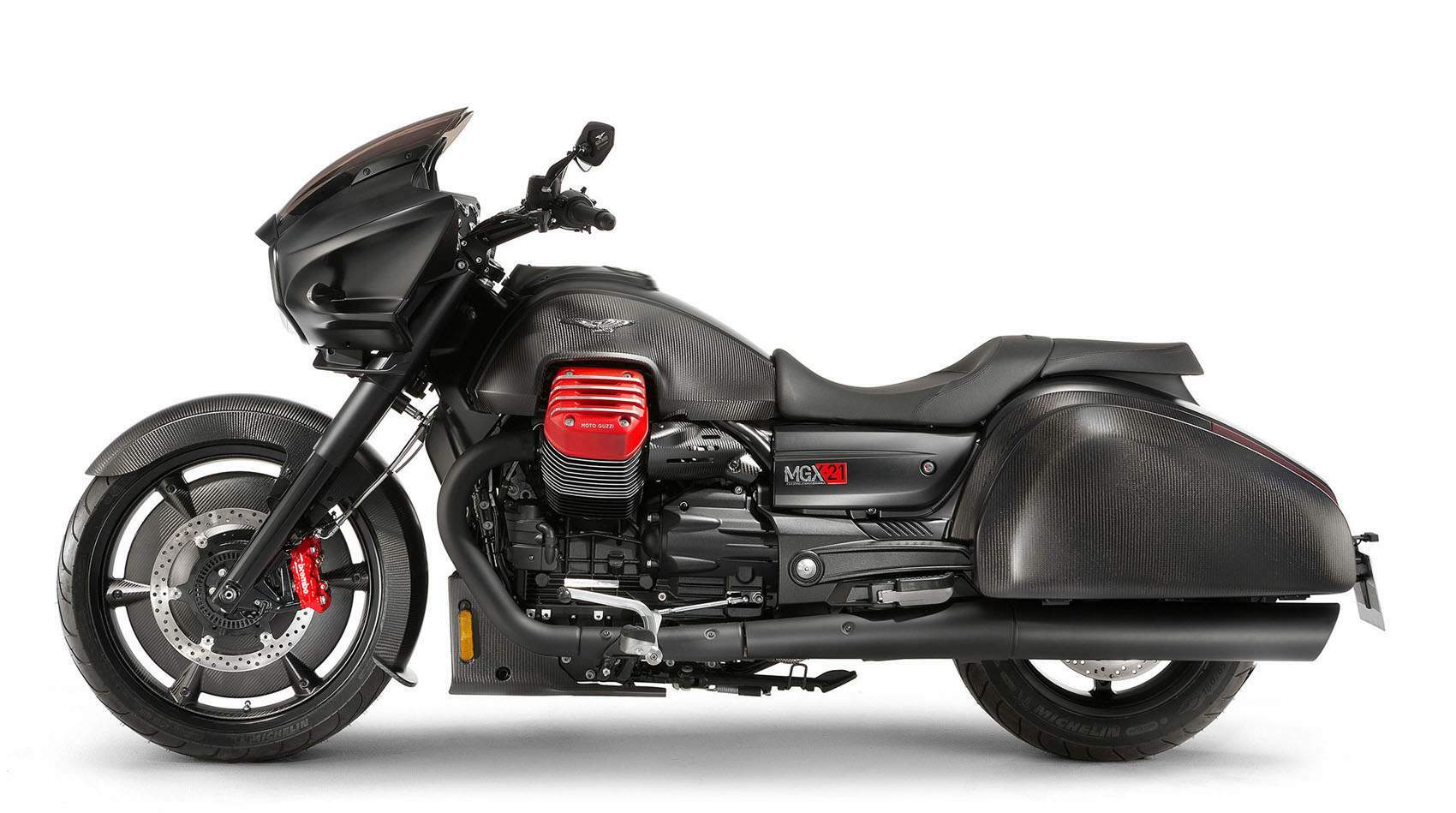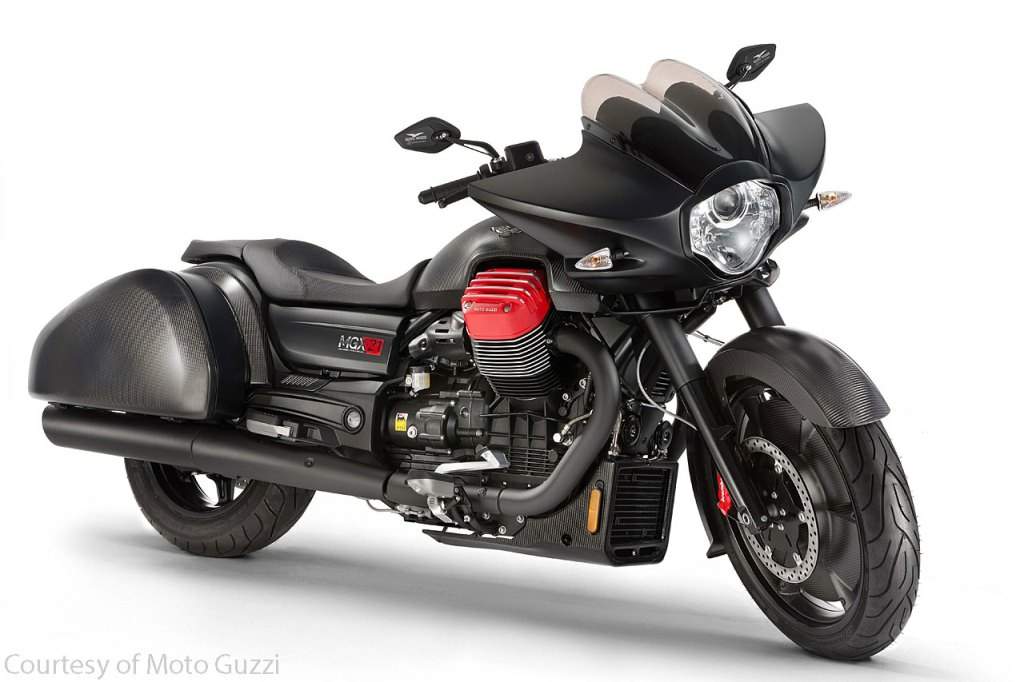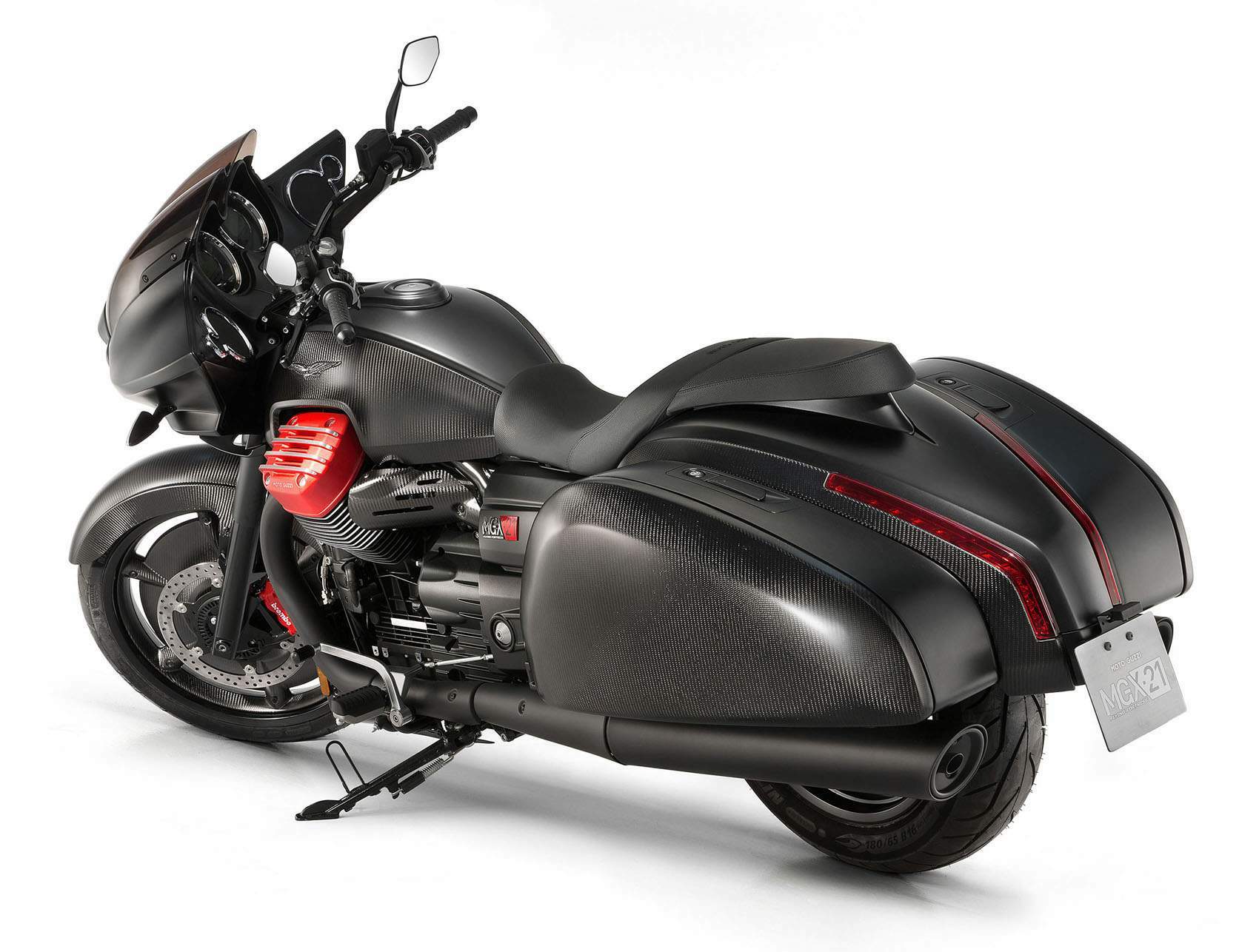
|
|
|
|
|
|
Classic Bikes
Custom Bikes
Individual
Racing Bikes AJP
AJS
Aprilia
Ariel
Avinton / Wakan
Bajaj
Benelli
Beta
Bimota
BMW
Brough Superior
BRP Cam-Am
BSA
Buell / EBR
Bultaco
Cagiva
Campagna
CCM
CF Moto
Combat Motors
Derbi
Deus
Ducati
Excelsior
GASGAS
Ghezzi Brian
Gilera
GIMA
Harley Davidson
Hero
Highland
Honda
Horex
Husaberg
Husqvarna
Hyosung
Indian
Jawa
Kawasaki
KTM
KYMCO
Laverda
Lazareth
Magni
Maico
Mash
Matchless
Mondial
Moto Guzzi
Moto Morini
MV Agusta
MZ / MuZ
NCR
Norton
NSU
Paton
Peugeot
Piaggio
Revival Cycles
Roland Sands
Royal Enfield
Sachs
Sherco
Sunbeam
Suzuki
SWM
SYM
Triumph
TVS
Ural
Velocette
Vespa
Victory
Vincent
VOR
Voxan
Vyrus
Walt Siegl
Walz
Wrenchmonkees
Wunderlich
XTR / Radical
Yamaha
Zero
Video
Technical
Complete Manufacturer List
|
Moto Guzzi MGX-21 Flying Fortress |
| . |
|
Make Model |
Moto Guzzi MGX-21 Flying Fortress |
|
Year |
2016 - 17 |
|
Engine |
Four stroke, 90° V-twin, SOHC, 4 valves per cylinder |
|
Capacity |
1380 cc / 84.2 cu-in |
| Bore x Stroke | 104 x 81.2 mm |
| Cooling System | Air/ oil cooled |
| Compression Ratio | 10.5:1 |
| Lubrication | Wet sump |
| Exhaust | Three-way catalyser with lambda probe |
| Timing System Diagram | Intake valve opens 19° BTDC (1-mm checking clearance) intake valve closes 55° ABDC exhaust valve opens 49° BBDC exhaust valve closes 12° ATDC |
|
Fuel Supply |
Magneti Marelli IAW7SM; “ride by wire” Ø 52 mm throttle body, IWP 243 Magneti Marelli injectors, double oxygen sensor, integrated management of 3 engine mappings, traction control, cruise control |
| Ignition | Phased electronic Multipoint sequential injection |
| Spark Plugs | NGK LMAR8F, 2 per cylinder |
|
Starting |
Electric |
| Exhaust system | Stainless steel, 2-in-2 type, three-way catalytic converter with double lambda probe |
| Battery | 12V - 18 Ah |
| Alternator | 12 V - 550 W |
|
Max Power |
96 hp / 71 kW @ 6500 rpm |
|
Max Torque |
89 ft/lb / 120 Nm @ 2750 rpm |
| Clutch | Single-disc with integrated anti-vibration buffer |
|
Transmission |
6 speeds with final overdrive |
| Final Drive | Shaft |
| Gear Ratio | 1st 17/38 = 1 : 2.235 2nd 20/34 = 1 : 1.700 3rd 23/31 = 1 : 1.348 4th 26/29 = 1 : 1.115 5th 31/30 = 1 : 0.968 6th 30/24 = 1 : 0.8 |
| Primary Drive | 26/35 = 1: 1,346) |
| Final Drive Ratio | Double cardan joint and fixed bevel gear seat, drive ratio 10/36 = 1: 3.6) |
| Frame | Double cradle tubular frame in ALS steel with detachable rear subframe |
|
Front Suspension |
Standard swingarm, Ø 46 mm, with radial calliper mounting bracket and telescopes on the stanchions, |
| Front Wheel Travel | 120 mm / 4.7 in |
|
Rear Suspension |
Swingarm with double shock absorber with adjustable spring preload. |
| Rear Wheel Travel | 110 mm / 4.3 in |
|
Front Brakes |
2x 320 mm stainless steel floating discs, Brembo radial callipers with 4 horizontally opposed pistons |
|
Rear Brakes |
Single 282 mm stainless steel fixed disc, Brembo floating calliper with 2 parallel pistons |
| Wheels | Spoked steel rims |
| Front wheel | Aluminium alloy 3.50” x 18” |
| Rear Wheel | Aluminium alloy 6.00” x 16” |
|
Front Tyre |
130/70 R18 |
|
Rear Tyre |
200/60 R16 |
| Trail | 109 mm / 4.2 in |
| Steering Angle | 27°50’ |
| Dimensions |
Length 2445 mm / 90.2 in Width 940 mm / 37.0 in Height 1115 mm / 43.8 in |
| Wheelbase | 1695 mm / 66.7 in |
| Seat Height | 740 mm / 29.1 in |
| Ground Clearance | 165 mm / 6.4 in |
|
Curb Weight |
314 kg / 701 lbs |
|
Fuel Capacity |
20.5 Litres / 5.4 US gal |
| Reserve | 5 Litres / 1.3 gal |

The MGX-21 is based on the California 1400 platform, sharing the same 1380cc 90-degree V-Twin producing a claimed 88.5 lb-ft. of torque. While the original California 1400 represented a classic style, the MGX-21 adopts a more futuristic look.
The Flying Fortress stays fairly true to the original concept, but with saddlebags rather than the wasp-like tail bodywork on the prototype that only hinted at potential storage space. The fairing is heavily sculpted, almost as if Moto Guzzi wanted to redefine the term “batwing fairing.”
One of the defining features of Moto Guzzi’s bagger is the extensive use of carbon fiber, from the saddlebags to the tank panels, front fender, case covers and front wheel covers. The wheel covers are chosen because Moto Guzzi states they “increase stability and ease of handling due to the passage of air from one side of the hub to the other while the bike is in motion.”
The rangeof electronic rider aids help the MGX-21 stand out. As with the California 1400, the MGX-21 comes with three levels of traction control that can be turned off altogether, three riding modes, two-channel ABS, cruise control and a ride-by-wire system as standard equipment. Its lighting system is comprised of LEDs. The MGX-21 has a monochrome dot matrix display and an entertainment system that includes a stereo, intercom system and Bluetooth connectivity.
Gulluzi, head of the Piaggio Advanced Design Center in Pasadena, CA, said the following about the MGX-21:
“How do we imagine crossing an entire continent on a Moto Guzzi? This is the first question we asked ourselves and the immediate response was, on board a California 1400, a classic that has just been renewed. But we wanted to push beyond our thoughts and dreams, to take a leap into the future. We dared imagine a different way of travelling, cooler, as the Americans would say. And we imagined that Moto Guzzi would design and build its own bagger. How could that be? How could a project like this be steeped in Italian design? This is how our thinking and inspiration turned to the masters and masterpieces of Italian design. I mean Bertone and his extraordinary Alfa Romeo BATs of the 1950s, when these crazy Italians interpreted the American taste for extreme shapes such as fins and translated the wildest dreams into precious metal, masterfully combining Italian creativity with American pragmatism. And of course we thought about infinite spaces, with straight roads heading to distant horizons, to speed records snatched on the expanses of salt lakes, to travelling aimlessly and freely. In this way a indistinct image started to take on a definite shape, and thus the MGX-21 Flying Fortress was born.”

Features
Moto Guzzi's technological flag
The Flying Fortress raises Moto Guzzi's technological flag. The
new Italian bagger is distinguished by its high level contents
some of which are unique and patented, helping to maximise
riding pleasure and comfort, and of course safety. Behind the
cowl a sophisticated instrument panel has a monochrome dot
matrix display and real entertainment system. The latter
includes a stereo and the intercom system. The Bluetooth module
ensures full interaction with external devices such as a
smartphone, which can be used as a music player or to manage the
Moto Guzzi (MG-MP) multimedia platform, an exceptional source of
information for the journey. The standard equipment is
complemented by a sophisticated electronic engine management
system, which includes the Ride-by-Wire multimap, in addition to
two-channel ABS, traction control set to three different levels
of operation (and excludable) and cruise control. The new Moto
Guzzi also stands out for meticulous and obsessive attention to
detail. The spectacular optical units use LED technology, while
the electrical controls on the handlebars are made of metal.
While respecting the solid century-old tradition, the MGX-21
reaches out to the future, employing materials typically used in
the most advanced sports motorcycles. Indeed, many parts are
made in high quality carbon, such as the front mudguard, the
tank panels, the motorcycle case covers, the engine push rod and
the front wheel covers.
State of the art technology for maximum riding pleasure
The adoption of the 21" front wheel brought with it a major
evolution of the frame to ensure high levels of comfort and
riding pleasure. Moto Guzzi worked hard to define the new
steering geometry and ensure balance and ease of riding. In so
doing it thus combined the comfort and load capacity of a custom
with the dynamism and performance of a cruiser, two qualities
that are difficult to reconcile. The new tubular structure of
the closed double cradle frame adopts the ingenious
elastokinematic engine mounting system developed by Moto Guzzi
to eliminate vibrations transmitted to the rider when moving.
However, when stationary the bike still retains the throb of the
Moto Guzzi big block's two powerful 104 mm diameter pistons,
which can excite even the most streetwise motorcyclist,
intensifying the vibrancy of this model. The largest V-twin ever
produced in Europe, which can deliver more than 120 Nm of torque
with ease and precision from very low revs, has earned EU4
certification and a new exhaust unit with very long horizontal
terminals. All this verve is controlled by a benchmark brake
system for the category, worthy of a sports motorcycle,
comprising a trio of large diameter discs and four-piston front
callipers and radial connection.

|
Any corrections or more information on these motorcycles will be kindly appreciated. |